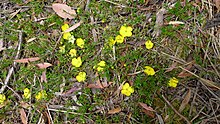Hibbertia procumbens, commonly known as spreading guinea flower,[2] is a species of flowering plant in the family Dilleniaceae and is endemic to south-eastern Australia. It is a prostrate, often mat-forming shrub with more or less glabrous stems, linear to narrow lance-shaped leaves with the narrower end towards the base, and yellow flowers with eighteen to twenty-five stamens arranged in groups around usually four glabrous carpels.
| Spreading guinea flower | |
|---|---|

| |
| Hibbertia procumbens near Lake St. Clair | |
| Scientific classification | |
| Kingdom: | Plantae |
| Clade: | Tracheophytes |
| Clade: | Angiosperms |
| Clade: | Eudicots |
| Order: | Dilleniales |
| Family: | Dilleniaceae |
| Genus: | Hibbertia |
| Species: | H. procumbens
|
| Binomial name | |
| Hibbertia procumbens | |
| Synonyms[1] | |
| |

Description edit
Hibbertia obtusifolia is a prostrate, often mat-forming shrub with more or less glabrous branches up to 30 cm (12 in) long. The leaves are linear to lance-shaped with the narrower end towards the base, 3–19 mm (0.12–0.75 in) long and 0.4–2.1 mm (0.016–0.083 in) wide with a rounded end and usually a groove along the upper surface. The flowers are arranged on the ends of branches and are sessile, surrounded by a cluster of up to six leaves. The sepals are 5.3–10.5 mm (0.21–0.41 in) long and of unequal lengths. The petals are bright yellow, egg-shaped with the narrower end towards the base, and 4.0–15 mm (0.16–0.59 in) long. There are eighteen to twenty-five stamens arranged in groups around usually four glabrous carpels. Flowering occurs from October to December.[2][3][4][5]
Taxonomy edit
Spreading guinea flower was first formally described in 1806 by Jacques Labillardière who gave it the name Dillenia procumbens in Novae Hollandiae Plantarum Specimen.[6][7] In 1817, Augustin Pyramus de Candolle changed the name to Hibbertia procumbens in Regni Vegetabilis Systema Naturale.[8][9] The specific epithet (procumbens) means "low-lying".
Distribution and habitat edit
Spreading guinea flower occurs in New South Wales, Victoria and Tasmania, growing in sandy soil, usually in heath. It is widespread and common in Tasmania, found in near-coastal areas of southern Victoria, but rare in New South Wales where it only occurs on the Central Coast near Somersby, Kulnura and Mangrove Mountain.[2][3][5][10]
Conservation status edit
Hibbertia procumbens is listed as "endangered" under the New South Wales Government Biodiversity Conservation Act 2016.[5]
References edit
- ^ a b "Hibbertia procumbens". Australian Plant Census. Retrieved 28 August 2021.
- ^ a b c "Hibbertia procumbens". Royal Botanic Garden Sydney. Retrieved 28 August 2021.
- ^ a b Toelken, Hellmut R. "Hibbertia procumbens". Royal Btanic Gardens Victoria. Retrieved 28 August 2021.
- ^ Wood, Betty. "Hibbertia procumbens". Lucid Keys. Retrieved 28 August 2021.
- ^ a b c "Spreading Guinea Flower - profile". New South Wales Government, Office of Environment and Heritage. Retrieved 28 August 2021.
- ^ "Dillenia procumbens". APNI. Retrieved 28 August 2021.
- ^ Labillardière, Jacques (1806). Novae Hollandiae Plantarum Specimen. Vol. 2. Paris. pp. 16–17. Retrieved 28 August 2021.
- ^ "Hibbertia procumbens". APNI. Retrieved 28 August 2021.
- ^ de Candolle, Augustin P. (1817). Regni Vegetabilis Systema Naturale. Paris. p. 427. Retrieved 28 August 2021.
- ^ Jordan, Greg. "Hibbertia procumbens". University of Tasmania. Retrieved 28 August 2021.